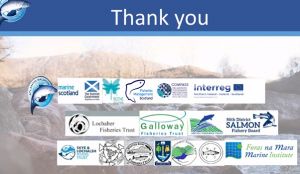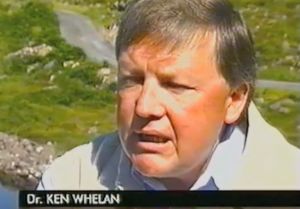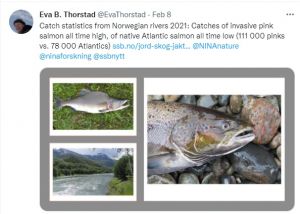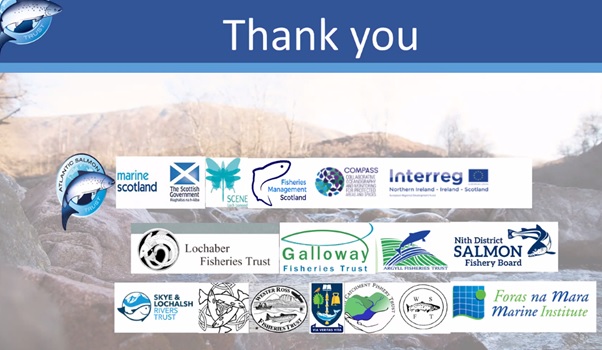Griggs: Professor Griggs published his 59-page review of the aquaculture regulatory process in Scotland this week as reported by the Press and Journal. The newspaper article is headlined ‘Fish farming face mistrust, dislike and vitriol’. This comes directly from the report in which Professor Griggs wrote that having carried out a number of similar reviews for the Scottish Government, he had never previously encountered:
The degree of mistrust, dislike, and vitriol at both an institutional and personal level between the industry (mainly finfish), certain regulators, parts of the Scottish Government and other stakeholders is at a level that I have never seen before which makes the current working relationships within the sector challenging.
His statement really resonates with me. This image that Professor Griggs portrays became apparent to me on day one of my journey to uncover the reality of interactions between farmed and wild salmon. Although, at the time not my area of expertise, I was asked to stand in at an event at Fishmongers Hall, then home of the Salmon & Trout Association (amongst others), to debate wild farmed interactions with Malcolm Windsor, then head of NASCO. I thought my presentation went relatively well but when we got to the Q&A, the mainly angling audience turned into what I can only describe as akin to a horde of football hooligans, becoming abusive and aggressive. I was repeatedly called a liar and told to admit that salmon farming was responsible for killing all the west coast salmon and sea trout. It was the abuse and seeming hatred that piqued my interest in learning more and I can safely say that in the eleven subsequent years, the mistrust, dislike and vitriol that I receive most weeks has never ceased. The one other common factor is the total reluctance to discuss any of the issues and as Professor Griggs rightly observes, this also applies to certain regulators, parts of the Scottish Government and other stakeholders from the wild sector.
The Press & Journal expands on the level of mistrust saying that it is such that there are those in the industry who believe officials within some regulations and government bodies have on occasion been actively briefing and supplying information against the industry to those that would seek to close it down completely. I can’t comment on such claims, but I do believe that some parts of Marine Scotland Science have an underlying negativity to salmon farming. This has become entrenched over many years and originated through the tenure of angler and wildfowler Dr Richard Shelton as head of the Freshwater Fisheries Laboratory from 1982 to 2001. His views on salmon farming are clearly expressed in his memoir – The Longshoreman (2004). In a section titled Children of the Spindrift he tells the story of the rise of salmon farming through the eyes of a retired navy captain who travels to Scotland every year to fish Loch Maree. He ends the section by saying that it was to be years before a reluctant government would grudgingly accept the disastrous consequences which their regional development policies had helped to create.
The angling commentator, the late Bruce Sandison, often used to criticise Dr Shelton saying that if he felt so strongly about salmon farming, why did he not speak up at the time for which the answer is not known, but what Dr Shelton did do was to surround himself with like-minded people – I know of someone who many years ago went for a job interview and asked about salmon farming and was told if you want to progress here, never repeat those dirty words here again – the consequences of which are now apparent. It is only necessary to look at the published MSS summary of sea lice science to see how selective the science against the salmon farming industry has become. This is also reflected in the SEPA consultation’s science justification for the spatial framework which will be discussed in reLAKSation at a later date. As discussed above, the fundamental problem is the total unwillingness of those involved to discuss any concerns.
I suspect that having stuck with a narrative for over thirty years it is difficult for many to admit that they might have been wrong.
Biologists: The unwillingness of the wild sector to discuss the issues about salmon farming was clearly apparent last week when fishery biologists, working for the various fishery boards and trusts, met on-line for their two-day annual meeting. One of the sessions was devoted to consideration of aquaculture issues and was chaired by Charlotte Middleton the Marine Scotland funded FMS interactions manager. The speakers and the topics covered included a review of sea trout by Dr Alan Walker co-chair of the ICES sea trout group; the risk to seatrout from sea lice infestation by Alan Kettle-White of Argyll Fisheries Trust; Sea lice infestation in Lochaber by Lucy Ballantyne of Lochaber Fisheries Trust; the influence of escaped salmon on the genetic integrity of wild salmon by Dr John Gilbey from Marine Science Scotland. The final speaker was Peter Pollard from SEPA who spoke on the wild fish and sea lice interaction framework (the absence of the word ‘proposed’ in the title of this presentation is noted). The presentations were followed by a discussion involving approximately sixty attendees.
I would like to be able to report what the various speakers covered as well as the content of the ensuing discussion but unfortunately, I did not receive an invitation to the meeting, not that I would ever expect one. The wild fish sector makes the most strenuous efforts to avoid any direct contact with me for reasons known only to themselves. I can only assume that they know that I will actively challenge their existing narrative about the impacts of salmon farming on wild fish. However, the fact that the Fishery Biologists meeting, which was run through the Scottish Fish Coordination Centre, part of FMS, did not invite anyone from the salmon farming industry to either speak or attend this event, demonstrates yet again, that the wild fish sector is not interested in anything but their own narrative of the impacts of salmon farming.
How can we ever move on unless there is an open and free discussion of the issues? Even the remit of the Government mediated Salmon Interactions Working Group did not allow for discussion of whether there is an impact of salmon farming on wild fish because I have been led to believe that the wild fish sector would have refused to attend if the group were to actually discuss whether there is an impact or not from sea lice on wild salmon.
Finally, given that SEPA are currently running a consultation on a proposed framework I hope that the salmon farming industry is given the same opportunity to hear Dr Pollard explain the proposal and engage in direct discussion.
NASCO: The North Atlantic Salmon Conservation Organisation (NASCO) have just published their report of a theme-based special session of the council held on 27th May 2021. The report is titled ‘Minimising Impacts of Salmon Farming on Wild Atlantic Salmon’.
The report begins by stating that the aim of NASCO’s theme based special sessions (TBSS) is to allow for greater exchange of information on a topic related to NASCO’s agreements and guidelines. However, on reading the report, it is apparent that this greater exchange applies to only information that proves salmon farming is damaging wild salmon. They are not interested in anything that might show that their perception of salmon farming is misguided.
The programme included one invited speaker from the International Salmon Farmers Association and his brief was to speak about improvements the industry is making to meet NASCO’s demands on sea lice control. They weren’t interested in hearing anything else. In fact, I am led to believe that NASCO rejected the proposed presentation submitted by the ISFA including a focus on the industry’s achievements and advancements. The final report glosses over much of the industry view.
My first interaction with NASCO occurred on day one of my journey into salmon interactions. Sadly, it has never really developed because any attempt to discuss the issues with the NASCO Secretariat has been rebuffed. Of course, this is not really surprising since the NASCO membership is dominated by representatives of the wild fisheries sector.
In my view, if NASCO was more open to discussion, the title of its report could be changed to ‘The Minimal Impacts of Salmon Farming on Wild Atlantic salmon’.
West Coast Tracking: This week, The Scottish Centre for Ecology and the Natural Environment (SCENE) ran a workshop bringing together the findings of the various salmon tracking projects now being carried out along the west coast of Scotland and around Ireland. This is because there is now so much overlap between the projects, the scale of which can be seen on the following image taken from the introduction.
I attended because one of the presentations covered the Atlantic Salmon Trust’s west coast tracking project, about which I have written previously. The project, which was conceived by Marine Scotland Science, is simply intended to show that wild salmon migrate past salmon farms or the sites of planned salmon farms and the information gathered can subsequently be used to support future objections to further expansion of the industry or, in certain circumstances, demands for closures of existing farms. However, the project has been presented as determining the migration routes of smolts leaving west coast rivers in order to help preserve stocks for the future. I am not party to the discussions, but I believe the salmon farming industry has been persuaded to help the project with the provision of significant funding over three years in the spirit of cooperation.
Despite the aim of the meeting being to share information, the participants of the workshop were presented with the following screen:

This stated: Please note that the preliminary findings discussed in this presentation are being shared for the purposes of today only and are not for public viewing, therefore these results are not to be shared. A full reporting of the preliminary findings will be available soon. Thank you for your understanding.
The text was repeated on every slide. As I am not supposed to share any information about the project, I will offer you the final slide of the presentation instead:

As you can see, the salmon industry funding is not publicised at all. The same occurred at the start when the list of participants was acknowledged but again there was no mention of the salmon industry at all. It seems that the AST are happy to take the money but not so keen to be seen to be taking it.
As for the preliminary results of the project, I was extremely underwhelmed. Some of it might be of academic interest, but I cannot see how any of this work will help safeguard wild salmon. The real problem is the number of salmon returning to Scottish shores has fallen significantly over the last fifty years and we really need to be finding out why if we are to halt the decline. I draw an analogy from the rail network. It is possible to travel direct from London to Edinburgh along the east or west coast mainlines. It doesn’t really matter which you use as long as you get there and back. Currently, fewer salmon are making the return trip. We need to know why.
The focus on the west coast is misguided. Since 2010, catches in areas where there are no salmon farms have fallen by 60%. In 2020 there were 62539 fewer fish caught than ten years earlier. On the west coast, the number is 47% down and that amounts to just 3,500 fish less. Given that the Tweed catch in 2020 was 8,215 fish, the west coast is simply a distraction.
The workshop was wound up by Ken Whelan, research director of the AST. By coincidence I was sent a video of an Irish TV programme about salmon farming from 2003 in which Dr Whelan featured. His words are extremely relevant to this debate. He told the programme that:
“There are certainly some fisheries that believe there is a connection” (between sea lice from salmon farms and fewer wild salmon) “but at this stage we have no proof, and we have to work on the basis of published information and until we see it, I will maintain there is absolutely no evidence in Ireland that there is any linkage between any problems with salmon and any sea lice problems”.

I would question whether there has been any other evidence published since 2003 which might have changed Dr Whelan’s view. As for the tracking project, I will discuss the results when they have been published in a form to make them less underwhelming.
Celebration: Fisheries Management Scotland has been celebrating Women in Science highlighting some of the women who work in the Fishery Boards and Trusts sector. One of the first to be mentioned was Dr Shona Marshall of the West Sutherland Fisheries Trust. I would certainly like to join FMS in celebrating Dr Marshall’s work and especially her scientific research that was published in 2003. This was reported at the time by the Washington Fish Growers Association in their newsletter. They say that Dr Shona Marshall of the WSFT spent four years from 1998 to 2001 researching the effects of fish farms on wild sea trout in Loch Laxford and has presented her findings in the Bulletin of the European Association of Fish Pathologists. The site was chosen because the fish farm in the Loch, owned and run by Loch Duart rotates production around three different lochs in the area leaving the test area fallow in some years and was judged to provide a unique opportunity to assess the relationship between the farmed salmon and lice abundance on wild trout.
Dr Marshall found that when there was no salmon farming in the loch, sea lice levels remained relatively constant on wild fish. In addition, in the year 2000 when infestations within the farm could be expected to be at their highest as a result of the production cycle, significantly less lice were found on the farmed fish than in the wild. This and other observations suggested that the relationship between sea lice on farmed salmon and wild trout was not direct.
Professor Christina Sommerville, an expert on fish parasites said that the study shows that there are no clear relationships between the infections of lice on farmed salmon and those on sea trout throughout the study period. At the time, the salmon industry said that the study revealed other factors had a greater importance in bringing about the decline of wild sea trout in Scotland, a view I very much share today.
Of course, Dr Marshall’s paper has been widely ignored by those working in the wild fish sector. However, over the years it has been regularly cited in other studies including in Eva Thorstad and others literature review of the effects of sea lice on wild sea trout (2015). However, Eva Thorstad and her colleagues dismiss Dr Marshall’s findings claiming that low lice levels on wild sea trout might be an indication of a premature return to freshwater. Yet, if this is considered to be a natural response to high lice levels, then researchers should never find trout with high levels of lice at all because the fish would have taken the freshwater de-licing option and clearly a lot of sea trout don’t. I suspect that premature return to freshwater might have more to do with the complex life cycle of some sea trout.
Regardless of what others think, I certainly believe Dr Marshall’s work should be celebrated by all those working with salmon, whether wild or farmed.
And finally: Eva Thorstad, co-chair of the Committee for Scientific Salmon Management (VRL) tweeted this week that the catch of salmon from Norwegian rivers was dominated by invasive pink salmon (111,000) whilst the catch of Atlantic salmon was at an all-time low (78,000).

VRL say that salmon farming is the greatest threat to wild Atlantic salmon, hence the low number, yet colleagues from Canada say that the declines of pinks there is due to salmon farms too. How can they be declining around one nation’s salmon farms yet be increasing in the world’s number one salmon farming nation?
The only reasonable answer is that salmon farms are not the common factor, except to be the scapegoat. I look forward to hearing an explanation in due course.

